释意学派理论的发展概述
法国释意理论的国内外研究现状

作 者 简 介 :范 丽 娟 (1987一)女 ,汉 族 ,山 东 济 南 ,山东 师 范 大 学 研 究 生 ,研 究 方 向 :英 语课 程 与 教学 论
文 学 界 · 70 -
语 言 研 究
系统 地 介 绍 过 释 意 学 派 理 论 的 基 本 观 点 、理 论 术 语 和 该 学 派 在 口译 过 程 、口译 质 量 评 价 以 及 口译 教 学 中 的 运 用 情 况 。她 的 主 要 贡 献 不 仅 在 于 把 法 国 口译 释 意 学 派 的理 论 系统 地 介 绍 到 中 国 ,还 在 于 统 一 了 该 学 派 专 业 术 语 的 中 文 译 名 ,是 最 早 正 式 开 始使 用 “释 意 派 ”一 词 的 学 者 。例如 ,2001年她 在 《中 国翻 译 》第 4期 发 表 的 《释 意 学 派 理 论 对 翻 译 学 的 主 要 贡 献 》中 ,系 统 地 介 绍 了 释 意 学 派 理 论 的 诞 生 和 理 论 特 点 :(1) 口译 一 双 语 交 际 行 为 的 观 察 哨 所 ;(2) 脱 离 原 语 语 言外 壳 一 思 维 过 程 和 意 义 的 产 生 (3)释 意 学 派 的 “忠 实 意 义 ”一 忠 实 于 作 者 欲 言 ,忠 实 于 目 的 语 ,忠 实 于 译 文 读 者 。除 刘 和 平 外 ,鲍 刚 、蔡 小 红 等 对 释 意 理 论 的 研 究 受 人 关 注 ,鲍 刚 在 巴 黎 进 修 时 就 注 意 到 ,释 意 学 派 理 论 提 出 的 “脱 离 原 语 语 言 外 壳 ”的 实 践 性 很 强 ,便 从 语 言 心 理 学 、 信 息 论 、神 经 语 言 学 等 角 度 进 行 研 究 ,完 成 了 《口 译 理 论 概 述 》 一 书 。 蔡 小 红 曾 在 法 国 巴黎 高 等 翻 译 学 校 进 修 ,其 研 究 主 要 是 集 中 在 口译 过 程 的 实 证 研 究和 口译 质 量 的评 估 方 面 ,在 其 博 士 论文《交替传译过程 及其能力发展一 中国法语译 员和 学生 的交 替 传 译 活 动 实 证 研 究 》一 文 中 ,分 析 归 纳 出 交 替 传 译 中 心 理 语 言 活 动 的 普 遍 规 律 ,揭 示 口译 技 能 的 实 质 和 影 响 口 译 能 力 发 展 的 主 要 原 因 。 后 来 此 理 论 又被 推 广 到 笔 译 中 ,研 究 的 范 围 扩 大 到 文 学 翻 译 、科 技 翻 译 、电 影 字 幕 翻 译 、哑 语 翻 译 等 领 域 。曹 娴 于 20o9年 福 建 省 外 国 语 文 学 会 2009年 年 会 暨 学 术 研 讨 会 论 文 集 上 发 表 的 《释 意 理 论 视 角 下 <高 老 头 >的 两 个 译 本 对 比 分 析 》则是该理论在 文学翻 译中应用的典范 。此外 ,还有针对释意 理 论 忠 实 性 概 念 进 行 讨 论 的 论 文 ,如 袁 筱 一 的 《论 释 意 理 论 的 忠 实 概 念 》等 。
释义理论
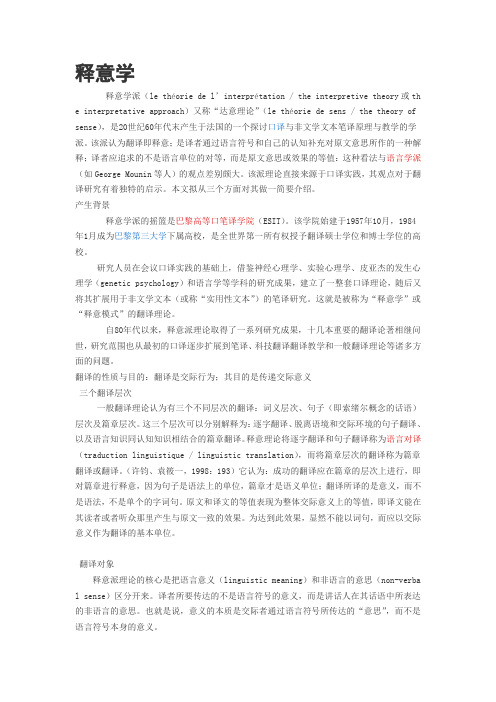
释意学释意学派(le théorie de l’interprétation / the interpretive theory或th e interpretative approach)又称“达意理论”(le théorie de sens / the theory of sense),是20世纪60年代末产生于法国的一个探讨口译与非文学文本笔译原理与教学的学派。
该派认为翻译即释意;是译者通过语言符号和自己的认知补充对原文意思所作的一种解释;译者应追求的不是语言单位的对等,而是原文意思或效果的等值:这种看法与语言学派(如George Mounin等人)的观点差别颇大。
该派理论直接来源于口译实践,其观点对于翻译研究有着独特的启示。
本文拟从三个方面对其做一简要介绍。
产生背景释意学派的摇篮是巴黎高等口笔译学院(ESIT)。
该学院始建于1957年10月,1984年1月成为巴黎第三大学下属高校,是全世界第一所有权授予翻译硕士学位和博士学位的高校。
研究人员在会议口译实践的基础上,借鉴神经心理学、实验心理学、皮亚杰的发生心理学(genetic psychology)和语言学等学科的研究成果,建立了一整套口译理论,随后又将其扩展用于非文学文本(或称“实用性文本”)的笔译研究。
这就是被称为“释意学”或“释意模式”的翻译理论。
自80年代以来,释意派理论取得了一系列研究成果,十几本重要的翻译论著相继问世,研究范围也从最初的口译逐步扩展到笔译、科技翻译翻译教学和一般翻译理论等诸多方面的问题。
翻译的性质与目的:翻译是交际行为;其目的是传递交际意义三个翻译层次一般翻译理论认为有三个不同层次的翻译:词义层次、句子(即索绪尔概念的话语)层次及篇章层次。
这三个层次可以分别解释为:逐字翻译、脱离语境和交际环境的句子翻译、以及语言知识同认知知识相结合的篇章翻译。
释意理论将逐字翻译和句子翻译称为语言对译(traduction linguistique / linguistic translation),而将篇章层次的翻译称为篇章翻译或翻译。
俄语翻译理论语言学派管窥
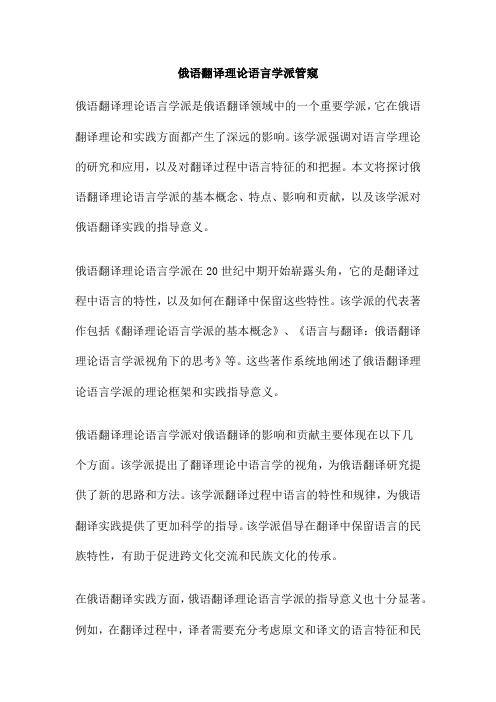
俄语翻译理论语言学派管窥俄语翻译理论语言学派是俄语翻译领域中的一个重要学派,它在俄语翻译理论和实践方面都产生了深远的影响。
该学派强调对语言学理论的研究和应用,以及对翻译过程中语言特征的和把握。
本文将探讨俄语翻译理论语言学派的基本概念、特点、影响和贡献,以及该学派对俄语翻译实践的指导意义。
俄语翻译理论语言学派在20世纪中期开始崭露头角,它的是翻译过程中语言的特性,以及如何在翻译中保留这些特性。
该学派的代表著作包括《翻译理论语言学派的基本概念》、《语言与翻译:俄语翻译理论语言学派视角下的思考》等。
这些著作系统地阐述了俄语翻译理论语言学派的理论框架和实践指导意义。
俄语翻译理论语言学派对俄语翻译的影响和贡献主要体现在以下几个方面。
该学派提出了翻译理论中语言学的视角,为俄语翻译研究提供了新的思路和方法。
该学派翻译过程中语言的特性和规律,为俄语翻译实践提供了更加科学的指导。
该学派倡导在翻译中保留语言的民族特性,有助于促进跨文化交流和民族文化的传承。
在俄语翻译实践方面,俄语翻译理论语言学派的指导意义也十分显著。
例如,在翻译过程中,译者需要充分考虑原文和译文的语言特征和民族文化特色,以确保翻译的准确性和可读性。
又如,该学派强调对原文的理解和对译文的表达能力,要求译者在翻译过程中不仅要忠实于原文的意思,还要考虑译文的语言习惯和文化背景。
俄语翻译理论语言学派具有较大的优势,但也存在一些不足之处。
该学派的优势在于它提出了翻译理论中语言学的视角,为俄语翻译研究提供了新的思路和方法。
不足之处在于,它尚未形成完整的理论体系,且在某些方面仍存在争议。
未来,随着语言学和翻译研究的深入发展,俄语翻译理论语言学派有望得到进一步完善和发展。
俄语翻译理论语言学派作为俄语翻译领域的一个重要学派,对俄语翻译理论和实践都产生了深远的影响。
它翻译过程中语言的特性和规律,为俄语翻译实践提供了更加科学的指导。
它倡导在翻译中保留语言的民族特性,有助于促进跨文化交流和民族文化的传承。
口译理论
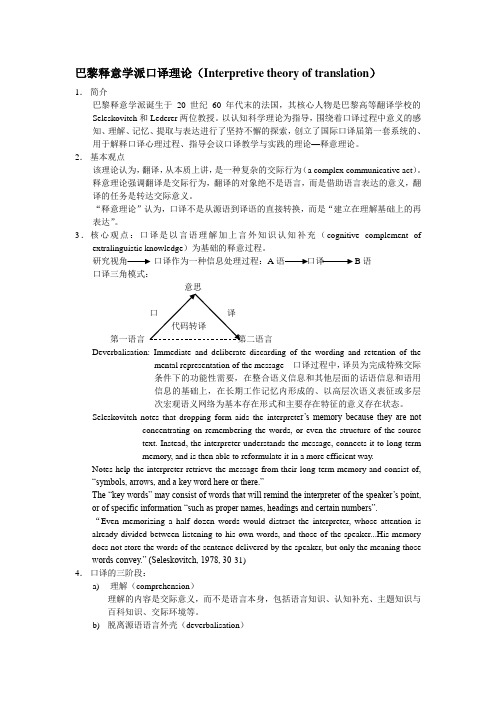
巴黎释意学派口译理论(Interpretive theory of translation)1.简介巴黎释意学派诞生于20世纪60年代末的法国,其核心人物是巴黎高等翻译学校的Seleskovitch和Lederer两位教授。
以认知科学理论为指导,围绕着口译过程中意义的感知、理解、记忆、提取与表达进行了坚持不懈的探索,创立了国际口译届第一套系统的、用于解释口译心理过程、指导会议口译教学与实践的理论—释意理论。
2.基本观点该理论认为,翻译,从本质上讲,是一种复杂的交际行为(a complex communicative act)。
释意理论强调翻译是交际行为,翻译的对象绝不是语言,而是借助语言表达的意义,翻译的任务是转达交际意义。
“释意理论”认为,口译不是从源语到译语的直接转换,而是“建立在理解基础上的再表达”。
3.核心观点:口译是以言语理解加上言外知识认知补充(cognitive complement of extralinguistic knowledge)为基础的释意过程。
研究视角口译作为一种信息处理过程:A语口译B语口译三角模式:第一语言Deverbalisation: Immediate and deliberate discarding of the wording and retention of the mental representation of the message 口译过程中,译员为完成特殊交际条件下的功能性需要,在整合语义信息和其他层面的话语信息和语用信息的基础上,在长期工作记忆内形成的、以高层次语义表征或多层次宏观语义网络为基本存在形式和主要存在特征的意义存在状态。
Seleskovitch notes that dropping form aids the interprete r’s memory because they are not concentrating on remembering the words, or even the structure of the sourcetext. Instead, the interpreter understands the message, connects it to long-termmemory, and is then able to reformulate it in a more efficient way.Notes help the interpreter retrieve the message from their long-term memory and consist of, “symbols, arrows, and a key word here or there.”The “key words” may consist of words that will remind the interpreter of the speaker’s point, or of specific information “such as proper names, headings and certain numbers”.“Even memorizing a half dozen words would distract the interpreter, whose attention is already divided between listening to his own words, and those of the speaker...His memory does not store the words of the sentence delivered by the speaker, but only the meaning those words convey.” (Seleskovitch, 1978, 30-31)4.口译的三阶段:a)理解(comprehension)理解的内容是交际意义,而不是语言本身,包括语言知识、认知补充、主题知识与百科知识、交际环境等。
★当代西方翻译理论流派评述及代表人物

翻译学必读1语文和诠释学派二十世纪之前的翻译理论被纽马克(1981)称为翻译研究的‘前语言学时期’,人们围绕‘word-for-word’和‘sense-for-sense’ 展开激烈的讨论,核心是‘忠实’,‘神似’和‘真理’。
典型的代表有John Dryden, Tytler等,而Barnard, Steiner等人则是在他们的基础上进一步发展。
2语言学派Jacobson(1959)提出意义对等的问题,随后的二十多当年,学界围绕这个问题进行了研究。
奈达(1969)采取了转换语法模式,运用“科学(奈达语)”的方法来分析他翻译《圣经》过程中的意义处理问题。
奈达提出的形式对等说、动态对等说和等效原则都是将注意力集中在受众一方。
纽马克信奉的是语义翻译和交际翻译,即重视翻译中的语义和交际方面。
3话语分析Discourse Analysis(critical discourse analysis批评话语分析functional discourse analysis功能语篇分析Discourse analysis theory话语分析理论Discourse Analysis for Interpreters翻译专业演说分析Pragmatics & Discourse Analysis语用学positive discourse analysis积极话语分析rhetorical or discourse analysis语篇分析Pragmatics and Discourse Analysis语用学Mediated discourse analysis中介话语分析二十世纪七十年代到九十年代,作为应用语言学领域的一个分支,话语分析经历了产生和发展壮大的过程,其理论背景来自(韩礼德)的系统功能语法。
今天,话语分析的方法已经逐步运用到翻译研究中。
House(1997)提出的翻译质量模型就是基于韩礼德的理论,他吸收了其中的语域分析方法;Baker(1992) 则为培养译员提供了话语分析和语用分析的范本;Hatim 和 Mason(1997)将语域研究拓展到语用和符号学角度4目的学派目的学派于二十世纪七、八十年代在德国兴起,是从静态的语言学、语言类型学中剥离出来的。
释意学派
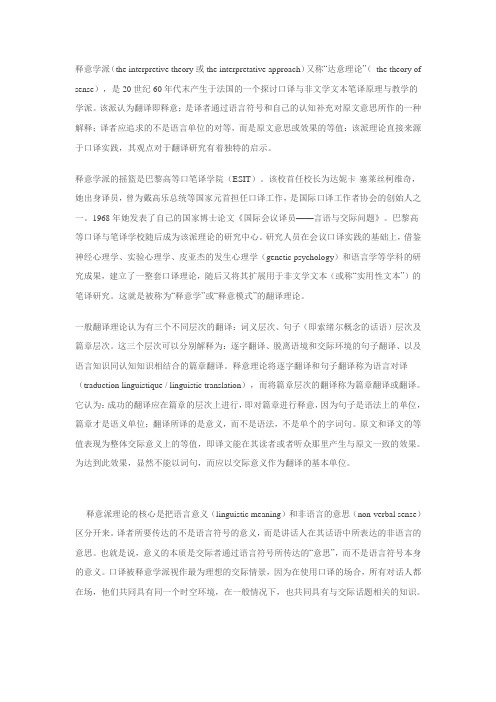
释意学派(the interpretive theory或the interpretative approach)又称“达意理论”(the theory of sense),是20世纪60年代末产生于法国的一个探讨口译与非文学文本笔译原理与教学的学派。
该派认为翻译即释意;是译者通过语言符号和自己的认知补充对原文意思所作的一种解释;译者应追求的不是语言单位的对等,而是原文意思或效果的等值:该派理论直接来源于口译实践,其观点对于翻译研究有着独特的启示。
释意学派的摇篮是巴黎高等口笔译学院(ESIT)。
该校首任校长为达妮卡·塞莱丝柯维奇,她出身译员,曾为戴高乐总统等国家元首担任口译工作,是国际口译工作者协会的创始人之一。
1968年她发表了自己的国家博士论文《国际会议译员——言语与交际问题》。
巴黎高等口译与笔译学校随后成为该派理论的研究中心。
研究人员在会议口译实践的基础上,借鉴神经心理学、实验心理学、皮亚杰的发生心理学(genetic psychology)和语言学等学科的研究成果,建立了一整套口译理论,随后又将其扩展用于非文学文本(或称“实用性文本”)的笔译研究。
这就是被称为“释意学”或“释意模式”的翻译理论。
一般翻译理论认为有三个不同层次的翻译:词义层次、句子(即索绪尔概念的话语)层次及篇章层次。
这三个层次可以分别解释为:逐字翻译、脱离语境和交际环境的句子翻译、以及语言知识同认知知识相结合的篇章翻译。
释意理论将逐字翻译和句子翻译称为语言对译(traduction linguistique / linguistic translation),而将篇章层次的翻译称为篇章翻译或翻译。
它认为:成功的翻译应在篇章的层次上进行,即对篇章进行释意,因为句子是语法上的单位,篇章才是语义单位;翻译所译的是意义,而不是语法,不是单个的字词句。
原文和译文的等值表现为整体交际意义上的等值,即译文能在其读者或者听众那里产生与原文一致的效果。
口译理论(优选.)
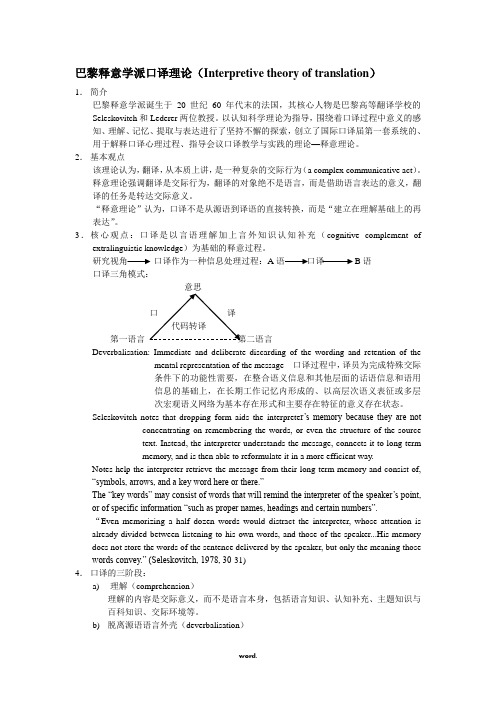
巴黎释意学派口译理论(Interpretive theory of translation)1.简介巴黎释意学派诞生于20世纪60年代末的法国,其核心人物是巴黎高等翻译学校的Seleskovitch和Lederer两位教授。
以认知科学理论为指导,围绕着口译过程中意义的感知、理解、记忆、提取与表达进行了坚持不懈的探索,创立了国际口译届第一套系统的、用于解释口译心理过程、指导会议口译教学与实践的理论—释意理论。
2.基本观点该理论认为,翻译,从本质上讲,是一种复杂的交际行为(a complex communicative act)。
释意理论强调翻译是交际行为,翻译的对象绝不是语言,而是借助语言表达的意义,翻译的任务是转达交际意义。
“释意理论”认为,口译不是从源语到译语的直接转换,而是“建立在理解基础上的再表达”。
3.核心观点:口译是以言语理解加上言外知识认知补充(cognitive complement of extralinguistic knowledge)为基础的释意过程。
研究视角口译作为一种信息处理过程:A语口译B语口译三角模式:第一语言Deverbalisation: Immediate and deliberate discarding of the wording and retention of the mental representation of the message 口译过程中,译员为完成特殊交际条件下的功能性需要,在整合语义信息和其他层面的话语信息和语用信息的基础上,在长期工作记忆内形成的、以高层次语义表征或多层次宏观语义网络为基本存在形式和主要存在特征的意义存在状态。
Seleskovitch notes that dropping form aids the interprete r’s memory because they are not concentrating on remembering the words, or even the structure of the sourcetext. Instead, the interpreter understands the message, connects it to long-termmemory, and is then able to reformulate it in a more efficient way.Notes help the interpreter retrieve the message from their long-term memory and consist of, “symbols, arrows, and a key word here or there.”The “key words” may consist of words that will remind the interpreter of the speaker’s point, or of specific information “such as proper names, headings and certain numbers”.“Even memorizing a half dozen words would distract the interpreter, whose attention is already divided between listening to his own words, and those of the speaker...His memory does not store the words of the sentence delivered by the speaker, but only the meaning those words convey.” (Seleskovitch, 1978, 30-31)4.口译的三阶段:a)理解(comprehension)理解的内容是交际意义,而不是语言本身,包括语言知识、认知补充、主题知识与百科知识、交际环境等。
口译即释意关于释意理论及有关争议的反思
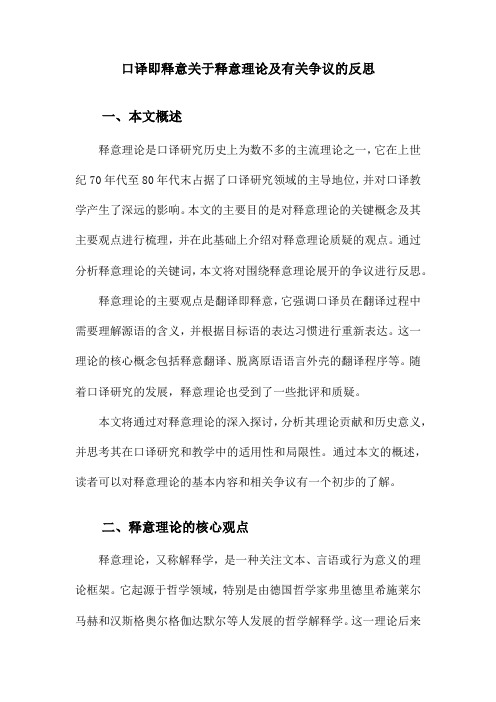
口译即释意关于释意理论及有关争议的反思一、本文概述释意理论是口译研究历史上为数不多的主流理论之一,它在上世纪70年代至80年代末占据了口译研究领域的主导地位,并对口译教学产生了深远的影响。
本文的主要目的是对释意理论的关键概念及其主要观点进行梳理,并在此基础上介绍对释意理论质疑的观点。
通过分析释意理论的关键词,本文将对围绕释意理论展开的争议进行反思。
释意理论的主要观点是翻译即释意,它强调口译员在翻译过程中需要理解源语的含义,并根据目标语的表达习惯进行重新表达。
这一理论的核心概念包括释意翻译、脱离原语语言外壳的翻译程序等。
随着口译研究的发展,释意理论也受到了一些批评和质疑。
本文将通过对释意理论的深入探讨,分析其理论贡献和历史意义,并思考其在口译研究和教学中的适用性和局限性。
通过本文的概述,读者可以对释意理论的基本内容和相关争议有一个初步的了解。
二、释意理论的核心观点释意理论,又称解释学,是一种关注文本、言语或行为意义的理论框架。
它起源于哲学领域,特别是由德国哲学家弗里德里希施莱尔马赫和汉斯格奥尔格伽达默尔等人发展的哲学解释学。
这一理论后来被应用于多个领域,包括文学研究、法律、心理学和口译等。
文本的多重意义:释意理论认为,文本不是静态的、单一意义的实体,而是具有多重潜在意义的动态结构。
每个读者或听者都会根据自己的背景知识和经验,对文本进行独特的解读。
读者的角色:在释意过程中,读者或听者扮演着至关重要的角色。
他们的预期、先入为主的观念和文化背景都会影响对文本的理解。
理解文本是一个主观的过程,每个个体的解释都是独一无二的。
历史和文化背景:释意理论强调历史和文化背景在理解过程中的重要性。
文本是在特定的历史和文化背景下产生的,理解文本需要对这些背景有所了解。
解释的循环:理解是一个循环往复的过程,称为“解释的循环”或“理解的循环”。
这意味着在理解一个文本时,我们不断地在整体和部分之间移动,从整体中理解部分,再从部分中理解整体。
综述释意学派翻译理论研究的主要内容
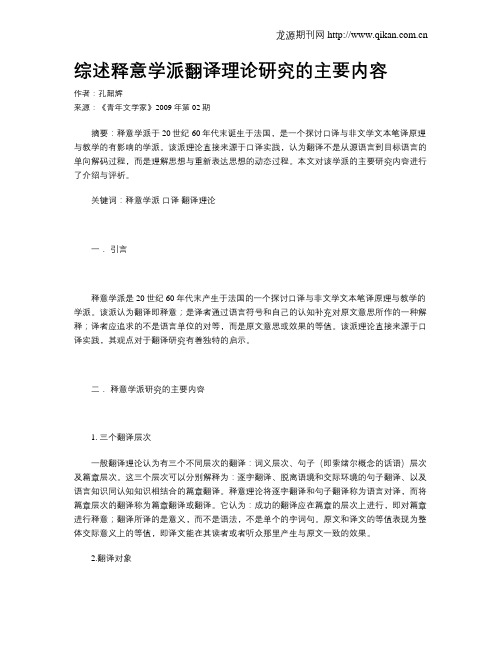
综述释意学派翻译理论研究的主要内容作者:孔韶辉来源:《青年文学家》2009年第02期摘要:释意学派于20世纪60年代末诞生于法国,是一个探讨口译与非文学文本笔译原理与教学的有影响的学派。
该派理论直接来源于口译实践,认为翻译不是从源语言到目标语言的单向解码过程,而是理解思想与重新表达思想的动态过程。
本文对该学派的主要研究内容进行了介绍与评析。
关键词:释意学派口译翻译理论一.引言释意学派是20世纪60年代末产生于法国的一个探讨口译与非文学文本笔译原理与教学的学派。
该派认为翻译即释意;是译者通过语言符号和自己的认知补充对原文意思所作的一种解释;译者应追求的不是语言单位的对等,而是原文意思或效果的等值。
该派理论直接来源于口译实践,其观点对于翻译研究有着独特的启示。
二.释意学派研究的主要内容1. 三个翻译层次一般翻译理论认为有三个不同层次的翻译:词义层次、句子(即索绪尔概念的话语)层次及篇章层次。
这三个层次可以分别解释为:逐字翻译、脱离语境和交际环境的句子翻译、以及语言知识同认知知识相结合的篇章翻译。
释意理论将逐字翻译和句子翻译称为语言对译,而将篇章层次的翻译称为篇章翻译或翻译。
它认为:成功的翻译应在篇章的层次上进行,即对篇章进行释意;翻译所译的是意义,而不是语法,不是单个的字词句。
原文和译文的等值表现为整体交际意义上的等值,即译文能在其读者或者听众那里产生与原文一致的效果。
2.翻译对象释意派理论的核心是把语言意义和非语言的意思区分开来。
译者所要传达的不是语言符号的意义,而是讲话人在其话语中所表达的非语言的意思。
也就是说,意义的本质是交际者通过语言符号所传达的“意思”,而不是语言符号本身的意义。
笔译与口译虽然形式不同,但本质上都是一种交际行为,只是在笔译中,所译材料与现实世界的关系不像在口译中那样密切而已。
口译则不同:它被释意学派视作最为理想的交际情景,因为在使用口译的场合,所有对话人都在场,他们共同具有同一个时空环境,在一般情况下,也共同具有与交际话题相关的知识。
★当代西方翻译理论流派评述及代表人物

★当代西方翻译理论流派评述及代表人物翻译学必读1语文和诠释学派二十世纪之前的翻译理论被纽马克(1981)称为翻译研究的‘前语言学时期’,人们围绕‘word-for-word’和‘sense-for-sense’ 展开激烈的讨论,核心是‘忠实’,‘神似’和‘真理’。
典型的代表有John Dryden, Tytler等,而Barnard, Steiner等人则是在他们的基础上进一步发展。
2语言学派Jacobson(1959)提出意义对等的问题,随后的二十多当年,学界围绕这个问题进行了研究。
奈达(1969)采取了转换语法模式,运用“科学(奈达语)”的方法来分析他翻译《圣经》过程中的意义处理问题。
奈达提出的形式对等说、动态对等说和等效原则都是将注意力集中在受众一方。
纽马克信奉的是语义翻译和交际翻译,即重视翻译中的语义和交际方面。
3话语分析Discourse Analysis(critical discourse analysis批评话语分析functional discourse analysis功能语篇分析Discourse analysis theory话语分析理论Discourse Analysis for Interpreters翻译专业演说分析Pragmatics & Discourse Analysis语用学positive discourse analysis积极话语分析rhetorical or discourse analysis语篇分析Pragmatics and Discourse Analysis语用学Mediated discourse analysis中介话语分析二十世纪七十年代到九十年代,作为应用语言学领域的一个分支,话语分析经历了产生和发展壮大的过程,其理论背景来自(韩礼德)的系统功能语法。
今天,话语分析的方法已经逐步运用到翻译研究中。
House(1997)提出的翻译质量模型就是基于韩礼德的理论,他吸收了其中的语域分析方法;Baker(1992) 则为培养译员提供了话语分析和语用分析的范本;Hatim 和Mason(1997)将语域研究拓展到语用和符号学角度~4目的学派目的学派于二十世纪七、八十年代在德国兴起,是从静态的语言学、语言类型学中剥离出来的。
释义理论
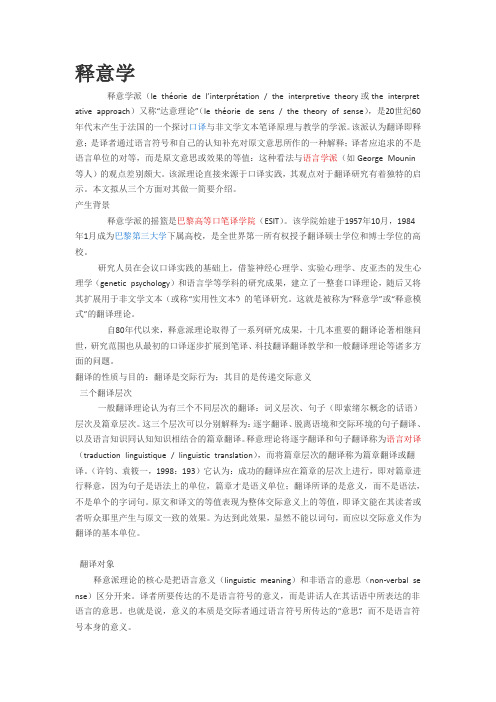
释意学释意学派(le théorie de l’interprétation / the interpretive theory或the interpret ative approach)又称“达意理论”(le théorie de sens / the theory of sense),是20世纪60年代末产生于法国的一个探讨口译与非文学文本笔译原理与教学的学派。
该派认为翻译即释意;是译者通过语言符号和自己的认知补充对原文意思所作的一种解释;译者应追求的不是语言单位的对等,而是原文意思或效果的等值:这种看法与语言学派(如George Mounin 等人)的观点差别颇大。
该派理论直接来源于口译实践,其观点对于翻译研究有着独特的启示。
本文拟从三个方面对其做一简要介绍。
产生背景释意学派的摇篮是巴黎高等口笔译学院(ESIT)。
该学院始建于1957年10月,1984年1月成为巴黎第三大学下属高校,是全世界第一所有权授予翻译硕士学位和博士学位的高校。
研究人员在会议口译实践的基础上,借鉴神经心理学、实验心理学、皮亚杰的发生心理学(genetic psychology)和语言学等学科的研究成果,建立了一整套口译理论,随后又将其扩展用于非文学文本(或称“实用性文本”)的笔译研究。
这就是被称为“释意学”或“释意模式”的翻译理论。
自80年代以来,释意派理论取得了一系列研究成果,十几本重要的翻译论著相继问世,研究范围也从最初的口译逐步扩展到笔译、科技翻译翻译教学和一般翻译理论等诸多方面的问题。
翻译的性质与目的:翻译是交际行为;其目的是传递交际意义三个翻译层次一般翻译理论认为有三个不同层次的翻译:词义层次、句子(即索绪尔概念的话语)层次及篇章层次。
这三个层次可以分别解释为:逐字翻译、脱离语境和交际环境的句子翻译、以及语言知识同认知知识相结合的篇章翻译。
释意理论将逐字翻译和句子翻译称为语言对译(traduction linguistique / linguistic translation),而将篇章层次的翻译称为篇章翻译或翻译。
以巴黎释意学派口译理论为例
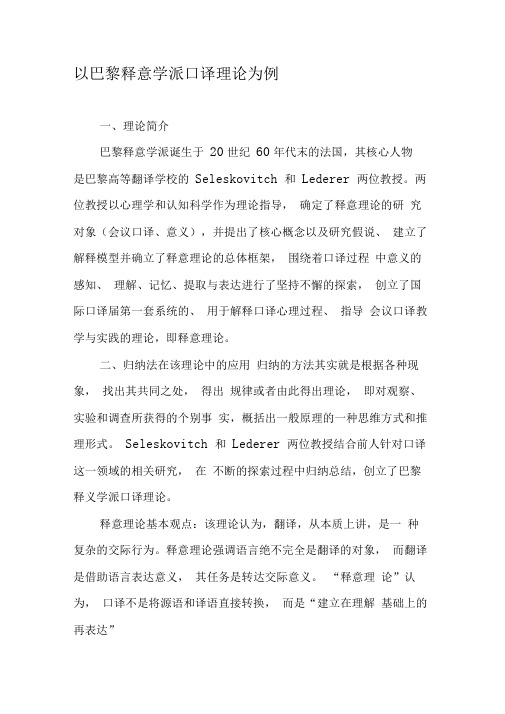
以巴黎释意学派口译理论为例一、理论简介巴黎释意学派诞生于20世纪60年代末的法国,其核心人物是巴黎高等翻译学校的Seleskovitch 和Lederer 两位教授。
两位教授以心理学和认知科学作为理论指导,确定了释意理论的研究对象(会议口译、意义),并提出了核心概念以及研究假说、建立了解释模型并确立了释意理论的总体框架,围绕着口译过程中意义的感知、理解、记忆、提取与表达进行了坚持不懈的探索,创立了国际口译届第一套系统的、用于解释口译心理过程、指导会议口译教学与实践的理论,即释意理论。
二、归纳法在该理论中的应用归纳的方法其实就是根据各种现象,找出其共同之处,得出规律或者由此得出理论,即对观察、实验和调查所获得的个别事实,概括出一般原理的一种思维方式和推理形式。
Seleskovitch 和Lederer 两位教授结合前人针对口译这一领域的相关研究,在不断的探索过程中归纳总结,创立了巴黎释义学派口译理论。
释意理论基本观点:该理论认为,翻译,从本质上讲,是一种复杂的交际行为。
释意理论强调语言绝不完全是翻译的对象,而翻译是借助语言表达意义,其任务是转达交际意义。
“释意理论”认为,口译不是将源语和译语直接转换,而是“建立在理解基础上的再表达”释意学派口译理论的核心观点:口译是对语言的理解再加上以语言外的知识作为补充的释意的过程。
它从研究视角出发再到将口译作为一种信息处理,该过程为A 语——口译——B 语。
口译过程中,译员需要将语义信息和其他层面的话语信息以及语用信息进行整合,并以高层次语义表征或多层次宏观语义形式表现出来。
通过长期的口译实践活动,Seleskovitch 总结出:口译不单单是一个语言符号的转换过程,而且还是一种交际活动,是理解意义后再进行表达的动态心理过程,这个过程和口译活动的主体译员有关。
因此,Seleskovitch 教授始终把译员和译员心理置于观察研究的中心位置,通过分析口译过程的各个阶段,把口译研究从语言结构的静态分析转为对意义传递过程的动态考察。
释意理论国内外研究的历史和状况
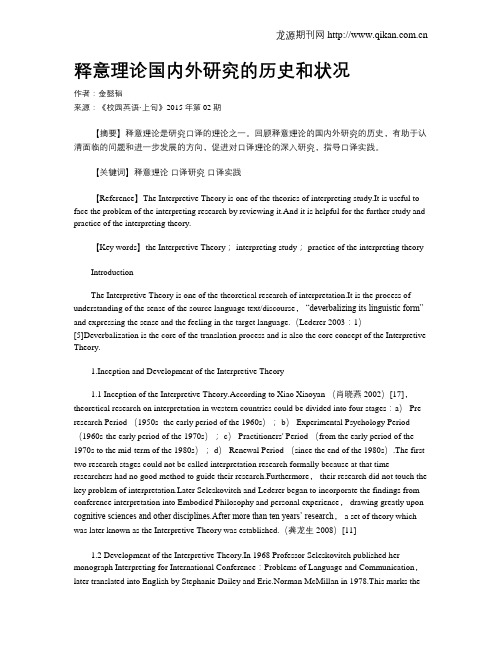
释意理论国内外研究的历史和状况作者:金懿韬来源:《校园英语·上旬》2015年第02期【摘要】释意理论是研究口译的理论之一。
回顾释意理论的国内外研究的历史,有助于认清面临的问题和进一步发展的方向,促进对口译理论的深入研究,指导口译实践。
【关键词】释意理论口译研究口译实践【Reference】The Interpretive Theory is one of the theories of interpreting study.It is useful to face the problem of the interpreting research by reviewing it.And it is helpful for the further study and practice of the interpreting theory.【Key words】the Interpretive Theory; interpreting study; practice of the interpreting theory IntroductionThe Interpretive Theory is one of the theoretical research of interpretation.It is the process of understanding of the sense of the source language text/discourse,“deverbalizing its linguistic form” and expressing the sense and the feeling in the target language.(Lederer 2003:1)[5]Deverbalization is the core of the translation process and is also the core concept of the Interpretive Theory.1.Inception and Development of the Interpretive Theory1.1 Inception of the Interpretive Theory.According to Xiao Xiaoyan (肖晓燕2002)[17],theoretical research on interpretation in western countries could be divided into four stages:a) Pre-research Period (1950s- the early period of the 1960s); b) Experimental Psychology Period (1960s-the early period of the 1970s); c) Practitioners' Period (from the early period of the 1970s to the mid-term of the 1980s); d) Renewal Period (since the end of the 1980s).The first two research stages could not be called interpretation research formally because at that time researchers had no good method to guide their research.Furthermore, their research did not touch the key problem of ter Seleskovitch and Lederer began to incorporate the findings from conference interpretation into Embodied Philosophy and personal experience, drawing greatly upon cognitive sciences and other disciplines.After more than ten years’ research, a set of theory which was later known as the Interpretive Theory was established.(龚龙生 2008)[11]1.2 Development of the Interpretive Theory.In 1968 Professor Seleskovitch published her monograph Interpreting for International Conference:Problems of Language and Communication,later translated into English by Stephanie Dailey and Eric.Norman McMillan in 1978.This marks thebirth of the Interpretive Theory and the preparation for the further development of the theory.(刘和平 2001b)[14].In 1984 Seleskovitch and Professor Lederer co-published the book entitled Interpreter pour Traduire1, marking the establishment of the Interpretative Theory.(龚龙生2008)[11]In 1994, Lederer published The Interpretive Model2, later translated into English by Ninon Larche in 2003.That marked the perfection of the Interpretive Theory.(龚龙生2008)[11]The three books mark the process of the foundation of the Interpretive Theory.The Interpretive Theory plays the important role in Chinese and international interpretation research.The following is the brief introduction to the concepts of the Interpretive Theory.2 Concepts of the Interpretive TheoryHere it is necessary to discuss three groups of key concepts of the Interpretive Theory—a)Translation through Interpretation; b) Translation Process with Deverbalization as its core; c)Sense, Units of Sense, Cognitive Inputs.(王斌华 2008)[16]2.1 Translation through Interpretation.The interpretive translation is not the transcoding between two languages.It means to translate or interpret the meaning of the source language text into the target language one completely and accurately.But how could it be done? What is the translation process?The other two groups of concepts should be introduced.2.2 Translation Process with Deverbalization as its Core2.2.1 Translation Process.In her monograph (Selekscovitch 1978:9)[6], Professor Selekscovitch mentioned three stages of the translation process which are understanding senses and feeling emotions of the source language text,“deverbalizing its linguistic form” and re-expressing its ideas and emotions in the target language.(Lederer 2003:1)[5]And the Paris School imagined this process to be a triangle.In 1984,Professor Seleskovitch and Professor Lederer proposed “the triangular model of interpretation”3 (Selekovitch & Lederer, 1984:168, 185 cited in 张吉良 2008:19)[21]again in the book named Intérpreter pour Traduire which was written by them.In this triangular model,two ends of the triangle’s bottom are the source language and the target language respectively.And the top of the triangle is the sense.The transcoding, which is from the source language to the target language, is not expected.But what is expected?That is “interpretive translation”.That is the process of comprehension of the sense of the source language discourse and reformulation of the sense and the feeling of the target language discourse.(张吉良 2008:19)[21]The following is the illustration of “the triangular model of the interpretation”.Figure 1 is two versions of the triangular model from Professor Seleskovitch (Seleskovitch & Lederer, 1984:168, 185 cited in张吉良2008:19)[21].Figure 1 (Seleskovitch & Lederer, 1984:168, 185 cited in 张吉良 2008:19)[21] And now ‘deverbalization’ will be explained in detail.2.2.2 Deverbalization.Deverbalization is the core of the translation process as well as the Interpretive Theory.From the above triangular model, it is clear that senses of the speaker in language 1 could be re-expressed to the listener in language 2 through deverbalization.Deverbalization is the indispensable phase between comprehension and reformulation.Through deverbalization, linguistic form is deverbalized but sense and emotion are produced.So the following is the explanation of “sense, units of sense,cognitive inputs”.2.3 Sense, Units of Sense, Cognitive Inputs.In the above two groups of concepts, it is mentioned that the content of translation or interpretation is the sense.And so is the goal of deverbalization.What is “sense”?The following is the introduction of “sense”.2.3.1 Sense.Sense is from language but beyond language.And it is the combination of the idea and the sign.Additionally, as Seleskovitch (Seleskovitch 1984:269 cited in Lederer 2003:15-16)[5]said that it is what an addresser wants to express but not anything else.And an interpreter should not do any explanation or comment casually.2.3.2 Units of Sense.Generally speaking,a unit of sense is “[…]this fusion of the semanticisms of words and cognitive inputs[…]” (Lederer 2003:18)[5].Furthermore the length of a unit of sense is changing.And different addressees have different units of sense because of their cognitive inputs.What is “cognitive inputs”? The explanation of the concept will be presented in the following paragraph.2.3.3 Cognitive Inputs.T o explain “cognitive inputs”, two concepts should be introduced.One is “world knowledge” and the other is “cognitive and affective inputs”.A.Cognitive and Affective InputsAlthough the concept is called “cognitive inputs”, it is also affective.Cognitive and affective are different but inseparable.Furthermore, according to Lederer (Lederer 2003:29)[5],in physiology they “[…]have their origins in the brain[…]” (ibid.)and also could be inseparable.And she used the term “cognitive inputs” to express them and divided them into “world knowledge” and “contextual knowledge”.Contextual knowledge is gained from hearing or reading a speech or a text and is stored in the short-term memory.It is short-lived.But it could “last long enough” for an interpreter or a translator to understand a speech or a text.(Lederer 2003:29-35)[5]But in the thesis it is not the point to be discussed more.The following is the explanation of “world knowledge” in detail.B.World KnowledgeWorld knowledge is also called encyclopaedic knowledge.And it includes “linguistic and extra-linguistic knowledge generally stored in the long-term memory” (Lederer 2003:29)[5].It is indispensable for the depth of understanding a speech or a discourse.Furthermore, it could be gained by “individuals through 1.their life’s experiences (empirical knowledge), nguage (what is learnt through reading, education, conversations, television, etc.),3.their own reasoning” (Lederer 2003:231)[5].And background knowledge is also “the relevant world or encyclopaedic knowledge” (ibid.).Without world knowledge, translation or interpretation will be the transcoding.The origin and concepts of the Interpretive Theory have been introduced.And the following is the reviewing of the research of the Interpretive Theory home and abroad.3.Research on the Interpretive Theory Home and Abroad3.1 Domestic Research on the Interpretive Theory.According to Zhang Jiliang (张吉良2008:21-26)[21], the Interpretive Theory was introduced in China in the 1970s.Studies in China have two ways.One way is translation and introduction of monographs of the Interpretive Theory.The representatives are Sun Huishuang,who translated L’interprète dans les Conférences Internationales, Problèmes de Langage et de Communication written by Seleskovitch (1979) and Interpréter pour Traduire written by Seleskovitch and Lederer (1992), Huang Weixin and Qian Huijie,who translated L’interprète dans les Conférences Internationale s, Problèmes de Langage et de Communication written by Seleskovitch (1992), Wang Jiarong, Li Xusen and Shi Meizhen, who translated Interpréter pour Traduire (1990), etc.The other one is the theoretical research and application.The representatives are Bao Gang, Liu Heping, Cai Xiaohong etc.They did the in-depth exploration (鲍刚 1998a, 1998b;蔡小红 2001;刘和平 2001a)[8][9][10][13], and some comments on the problems with the theory (鲍刚1998a, 1998b;刘和平2001b, 2006)[8][9][14][15].Apart from the above scholars, some other scholars, such as Xu Jun, Yuan Xiaoyi and Ke Ping, also did introduction and simple comment (袁筱一1997;许钧1998;许钧、袁筱一etc.2001)[20][18][19].Furthermore there are teachers who wrote papers about the Interpretive Theory.The papers mainly discussed the way to improve interpretation and the pedagogy of interpretation.Chinese researchers are more confined to the introduction and application; criticisms are rare. (张吉良 2008:21-26)[21]In his writing (龚龙生2008)[11], Gong Longsheng notes that Chinese schol ars’ contribution plays important role in the Chinese interpretation research and even in the whole translation theory research.It is also the indispensable part of the development of the Interpretive Theory, which shows the trend and direction of Chinese and global interpretation research—attaching importance to the empirical research, focusing on the interpretation process, studying from the perspective of the interdisciplinary and so on.(龚龙生 2008)[11]3.2 International Research on the Interpretive Theory.Theoretical research on interpretation in western countries has more than fifty years’ history.(李金泽2010)[12]The research could be divided into four stages which have been mentioned in Section 1.1.Stage 3 (from the early period of the 1970s to the mid-term of the 1980s),was called the Practitioners’ Period.The scholars of ESIT4 were the representatives of this stage.According to Zhang Jiliang’s research (张吉良2008:30)[21], before the mid-term of the 1980s, international interpretation circle mainly focused on the pedagogy of interpretation which was created on the basis of the Interpretive Theory (Gile 1990a, 1990b)[2][3]but they did not doubt the Interpretive Theory.However, in 1986, on the international seminar with the theme “Theory and Practice of the Conference Interpretation Teaching”, many participants challenged the views of the Paris School and called on using scientific and serious way to do the research of interpretation.(Crevatin 1989; Lambert 1989; Stenzl 1989)[1][4][7].Generally speaking, the research of the Interpretive Theory in international interpretation circle does not reap much.The critical writings of the Interpretive Theory are more than the praising ones.But the comments and criticisms are mainly about research methods and attitude of the Paris School.(张吉良 2008:30-41)[21]No one could deny the importance and historic value of the Interpretive Theory.The Interpretive Theory plays the important role in the pedagogy of interpretation and interpreters training when it is regarded as prescriptive theory though it really has problems when it is considered as explanatory theory.4.ConclusionFrom the above, the research and three groups of concepts of the Interpretive Theory have been reviewed.The importance and historic value of the Interpretive Theory could not bedenied.However, it has problems when it is considered as explanatory theory.So the in-depth research of the Interpretive Theory should attach importance to the empirical research, focusing on the interpretation process, studying from the perspective of the interdisciplinary and so on.Notes:1 This book has no English version, but it has two Chinese versions.One is entitled《口译理论实践与教学》which is translated by Wang Jiarong, Li Xusen and Shi Meizhen in 1990.The other is 《口笔译概论》 translated by Sun Huishuang in 1992.(张吉良2008:12)2 The book also has a Chinese version which is entitled《释意学派口笔译理论》and translated by Liu Heping and published by China Translation and Publishing Corporation in 2001.(张吉良2008:13)3 口译过程的三角模型4 ESIT即École Superieure d’Interprètes et de Traducteurs,法国巴黎新索邦大学高等翻译学校,简称巴黎高翻。
最有影响的西方三大口译理论整理
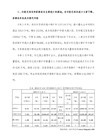
1. 原巴黎高等翻译学校的校长Seleskovitch创立的释意理论(theorie du sens)
释意理论是国际口译界出现的第一种系统的口译理论,它克服了同期笔译研究重“客体”轻“主体”的不足,开启了跨学科口译过程心理研究的先河。
巴黎释意学派诞生于20世纪60年代末的法国,其核心人物是巴黎高等翻译学校的Seleskovitch和Lederer两位教授。在她俩的带领下,巴黎高翻一批教师在从事口译教学与实践的同时,以认知科学理论为指导,围绕着口译过程中意义的感知、理解、记忆、提取与表达进行了坚持不懈的探索,创立了国际口译界第一套系统的、用于解释口译心理过程、指导会议口译教学与实践的理论———释意理论。巴黎释意学派便
在口译过程中有客观认知环境和译员自身的认知机制两个主要的认知维度,前者包括语言环境和非语言环境,后者包括译员的认知结构、认知处理资源、认知处理策略、认知心理能力等因素。在会议口译中会出现认知负荷超载现象,如高信息密集度、高信息复杂程度、高强度的工作压力等,解决该现象的一些应对策略,如建立图式知识网络、优化认知处理资源的分配、运用适当的认知处理策略等。
释意理论的一个突出特点是视口译为一种交际行为(过程)而非交际结果(译员表现、译语质量) ,为此它反复强调:口译的目的在于传递信息,其对象是意义而非语言,意义是语言知识、主题知识、百科知识和交际语境相结合的产物。
释意理论认为:口译的对象是意义而非语言。这就提醒口译员和口译师生,必须专注于意义的理解与表达,而不是寻求语言形式的对等。从事交替传译时,口译员由于短时记忆力不足,需要借助笔记来暂存信息。译员不能记录讲话人的全部语词,而要调动自己的语言外知识并结合交际语境边听边分析,以便把源语讲话的关键信息与话语逻辑用简洁的字词符号记录下来。之后,口译员还要对笔记内容进行解读,忠实传达出源语讲话的意义和情感,而不是进行语言符号的代码转换。
法国释意理论派
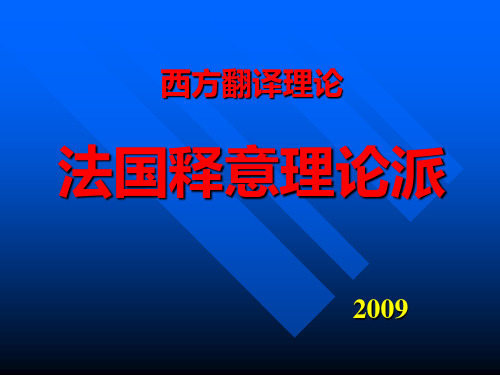
释意理论的基本问题
一、翻译的界定与对象 翻译的界定:塞莱丝柯维奇与勒代雷认为
翻译的对象:勒代雷认为翻译是理解原文
意义并用符合译语习惯的方式表达原语简单的 内容与信息,成功的翻译背后是对篇章的释意, 是语言外知识的参与,所以,翻译的对象不是 只字片语而是把握其主题及母语表达的篇章。 篇章既是翻译的对象又是翻译存在的理由。翻 译研究着重探讨的是翻译及其过程而不是翻译 的结果。
翻译程序与翻译评价标准
不同于通常的理解和表达的翻译程序,释 意理论认为翻译的模式是理解、脱离语言外壳 和重新表达。塞莱丝柯维奇把口译过程描述为 三角模式,即在理解和表达中间增加了“脱离 语言外壳”这一意义产生的阶段:三角的左边 是原语,右边是目的语,中间顶部是意义产生 阶段。这同我国学者劳陇的观点相似。
意义单位和语言单位与长度并不吻合,人们因 此理解一个意义单位的时间与听完一个语言片 断的时间也不相等,常常因语言交际中的诸多 因素的变化而变化。意义单位是在翻译中建立 等值关系的最小成分。塞莱丝柯维奇有关意义 单位的理论打破了传统的语言与意义不可分离 的观念,有利于译者摆脱原语语言结构形式的 束缚,更好地建立原文和译文之间交际意义或 交际功能上的等值。
试图借助应用语言学、篇章语言学、认知心理学、
能力发展模式等相关学科的研究成果从跨学科的 角度发展并完善这一理论。(3)遍布全球的该学 派研究人员在研究领域上不断拓宽,而且涉及近 二十种语言。
塞莱丝柯维奇创立的释意学理论将双语交际 作为研究的重点,把译员作为分析的对象,把翻 译的过程作为切入点,借助语言学等学科的理论 多方位思考,其目的是还翻译以本来的面目,其 结论自然同传统的语言学和翻译理论有一定差别。 像任何理论一样,释意理论有一个从建立到发展、 完善的过程,还有许多问题值得深入探讨:(1) 如何从神经学、认知心理学、心理语言学、信息 传递和控制论等理论高度说明并充分论证“脱离 原语语言外壳”、人的记忆载体等问题。
释意理论指导下的文化负载词翻译
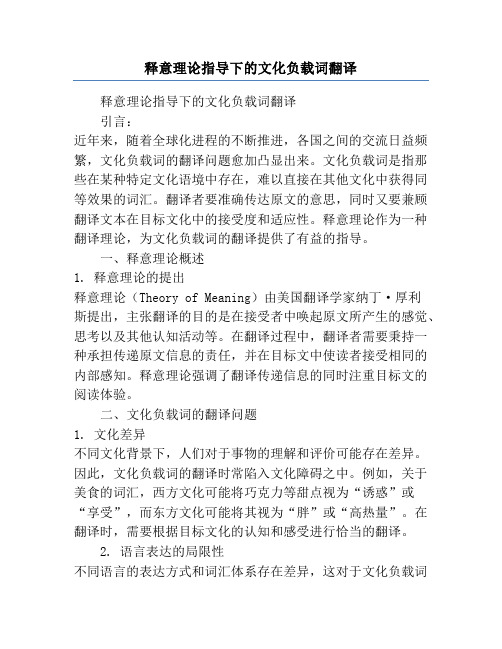
释意理论指导下的文化负载词翻译释意理论指导下的文化负载词翻译引言:近年来,随着全球化进程的不断推进,各国之间的交流日益频繁,文化负载词的翻译问题愈加凸显出来。
文化负载词是指那些在某种特定文化语境中存在,难以直接在其他文化中获得同等效果的词汇。
翻译者要准确传达原文的意思,同时又要兼顾翻译文本在目标文化中的接受度和适应性。
释意理论作为一种翻译理论,为文化负载词的翻译提供了有益的指导。
一、释意理论概述1. 释意理论的提出释意理论(Theory of Meaning)由美国翻译学家纳丁·厚利斯提出,主张翻译的目的是在接受者中唤起原文所产生的感觉、思考以及其他认知活动等。
在翻译过程中,翻译者需要秉持一种承担传递原文信息的责任,并在目标文中使读者接受相同的内部感知。
释意理论强调了翻译传递信息的同时注重目标文的阅读体验。
二、文化负载词的翻译问题1. 文化差异不同文化背景下,人们对于事物的理解和评价可能存在差异。
因此,文化负载词的翻译时常陷入文化障碍之中。
例如,关于美食的词汇,西方文化可能将巧克力等甜点视为“诱惑”或“享受”,而东方文化可能将其视为“胖”或“高热量”。
在翻译时,需要根据目标文化的认知和感受进行恰当的翻译。
2. 语言表达的局限性不同语言的表达方式和词汇体系存在差异,这对于文化负载词的翻译造成了困扰。
某些词汇在源文中可能具有丰富而充实的意义,但目标文中没有对应的词汇。
例如,中文的“痴迷”在英文中最常用的翻译是“obsession”,但这个词并不能完全表达“痴迷”的深度和执着感。
在这种情况下,翻译者需要根据原文语境及释意理论的指导,寻找最恰当的表达方式。
三、释意理论在文化负载词翻译中的应用1. 保持意义的多样性释意理论主张在翻译过程中保持原文的多样性,并追求逐层渗透式地传递原文的意义。
对于文化负载词,可以在目标文中用不同的表达方式来呈现原文的意义。
例如,对于中文的“炒鱿鱼”一词,英文中可以有多种翻译,如“get rid of someone”、“dismiss someone”等。
释意理论国内外研究的历史综述分析.docx
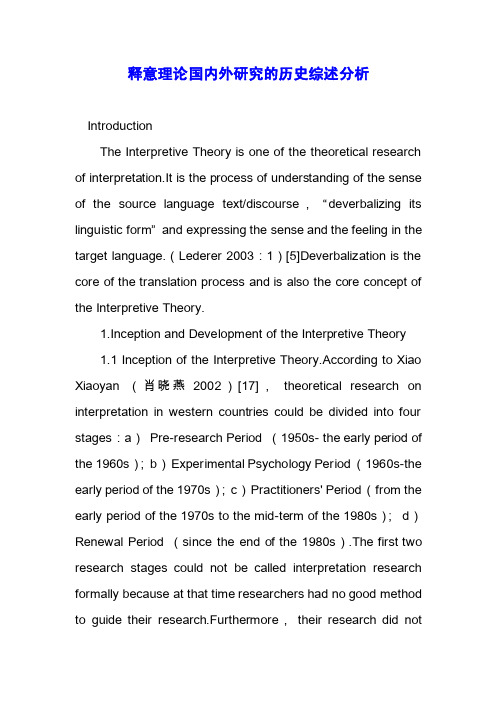
释意理论国内外研究的历史综述分析IntroductionThe Interpretive Theory is one of the theoretical research of interpretation.It is the process of understanding of the sense of the source language text/discourse,“deverbalizing its linguistic form”and expressing the sense and the feeling in the target language.(Lederer 2003:1)[5]Deverbalization is the core of the translation process and is also the core concept of the Interpretive Theory.1.Inception and Development of the Interpretive Theory1.1 Inception of the Interpretive Theory.According to Xiao Xiaoyan (肖晓燕2002)[17],theoretical research on interpretation in western countries could be divided into four stages:a)Pre-research Period (1950s- the early period of the 1960s);b)Experimental Psychology Period (1960s-the early period of the 1970s);c)Practitioners' Period (from the early period of the 1970s to the mid-term of the 1980s);d)Renewal Period (since the end of the 1980s).The first two research stages could not be called interpretation research formally because at that time researchers had no good method to guide their research.Furthermore,their research did nottouch the key problem of ter Seleskovitch and Lederer began to incorporate the findings from conference interpretation into Embodied Philosophy and personal experience,drawing greatly upon cognitive sciences and other disciplines.After more than ten years’ research,a set of theory which was later known as the Interpretive Theory was established.(龚龙生2008)[11]1.2 Development of the Interpretive Theory.In 1968 Professor Seleskovitch published her monograph Interpreting for International Conference:Problems of Language and Communication,later translated into English by Stephanie Dailey and Eric.Norman McMillan in 1978.This marks the birth of the Interpretive Theory and the preparation for the further development of the theory.(刘和平2001b)[14].In 1984 Seleskovitch and Professor Lederer co-published the book entitled Interpreter pour Traduire1,marking the establishment of the Interpretative Theory.(龚龙生2008)[11] In 1994,Lederer published The Interpretive Model2,later translated into English by Ninon Larche in 2003.That marked the perfection of the Interpretive Theory.(龚龙生2008)[11]The three books mark the process of the foundation of theInterpretive Theory.The Interpretive Theory plays the important role in Chinese and international interpretation research.The following is the brief introduction to the concepts of the Interpretive Theory.2 Concepts of the Interpretive TheoryHere it is necessary to discuss three groups of key concepts of the Interpretive Theory—a)Translation through Interpretation;b)Translation Process with Deverbalization as its core;c)Sense,Units of Sense,Cognitive Inputs.(王斌华2008)[16]2.1 Translation through Interpretation.The interpretive translation is not the transcoding between two languages.It means to translate or interpret the meaning of the source language text into the target language one completely and accurately.But how could it be done?What is the translation process?The other two groups of concepts should be introduced.2.2 Translation Process with Deverbalization as its Core2.2.1 Translation Process.In her monograph (Selekscovitch 1978:9)[6],Professor Selekscovitch mentioned three stages of the translation process which are understanding senses and feeling emotions of the sourcelanguage text,“deverbalizing its linguistic form”and re-expressing its ideas and emotions in the target language.(Lederer 2003:1)[5]And the Paris School imagined this process to be a triangle.In 1984,Professor Seleskovitch and Professor Lederer proposed “the triangular model of interpretation” 3 (Selekovitch & Lederer,1984:168,185 cited in 张吉良2008:19)[21]again in the book named Intérpreter pour Traduire which was written by them.In this triangular model,two ends of the triangle’s bottom are the source language and the target language respectively.And the top of the triangle is the sense.The transcoding,which is from the source language to the target language,is not expected.But what is expected?That is “interpretive translation”.That is the process of comprehension of the sense of the source language discourse and reformulation of the sense and the feeling of the target language discourse.(张吉良2008:19)[21]The following is the illustration of “the triangular model of the interpretation”.Figure 1 is two versions of the triangular model from Professor Seleskovitch (Seleskovitch & Lederer,1984:168,185 cited in张吉良2008:19)[21].Figure 1 (Seleskovitch & Lederer,1984:168,185 cited in 张吉良2008:19)[21]And now ‘deverbalization’ will be explained in detail.2.2.2 Deverbalization.Deverbalization is the core of the translation process as well as the Interpretive Theory.From the above triangular model,it is clear that senses of the speaker in language 1 could be re-expressed to the listener in language 2 through deverbalization.Deverbalization is the indispensable phase between comprehension and reformulation.Through deverbalization,linguistic form is deverbalized but sense and emotion are produced.So the following is the explanation of “sense,units of sense,cognitive inputs”.2.3 Sense,Units of Sense,Cognitive Inputs.In the above two groups of concepts,it is mentioned that the content of translation or interpretation is the sense.And so is the goal of deverbalization.What is “sense”?The following is the introduction of “sense”.2.3.1 Sense.Sense is from language but beyondlanguage.And it is the combination of the idea and the sign.Additionally,as Seleskovitch (Seleskovitch 1984:269 cited in Lederer 2003:15-16)[5]said that it is what an addresser wants to express but not anything else.And an interpreter should not do any explanation or comment casually.2.3.2 Units of Sense.Generally speaking,a unit of sense is “[…]this fusion of the semanticisms of words and cognitive inputs[…]”(Lederer 2003:18)[5].Furthermore the length of a unit of sense is changing.And different addressees have different units of sense because of their cognitive inputs.What is “cognitive inputs”?The explanation of the concept will be presented in the following paragraph.2.3.3 Cognitive Inputs.To explain “cognitive inputs”,two concepts should be introduced.One is “world knowledge”and the other is “cognitive and affective inputs”.A.Cognitive and Affective InputsAlthough the concept is called “cognitive inputs”,it is also affective.Cognitive and affective are different but inseparable.Furthermore,according to Lederer (Lederer 2003:29)[5],in physiology they “[…]have their origins in the brain[…]”(ibid.)and also could be inseparable.And she usedthe term “cognitive inputs”to express them and divided them into “world knowledge”and “contextual knowledge”.Contextual knowledge is gained from hearing or reading a speech or a text and is stored in the short-term memory.It is short-lived.But it could “last long enough”for an interpreter or a translator to understand a speech or a text.(Lederer 2003:29-35)[5]。
中国古代释家文学刍议

2023-10-30•引言•释家文学的起源与演变•释家文学的特点与价值目录•释家文学的代表作品与人物•结论与展望•参考文献01引言背景与意义中国古代释家文学的历史背景和文化内涵中国古代释家文学是中国古代文学的重要组成部分,具有深刻的历史背景和文化内涵。
通过对中国古代释家文学的研究,可以深入了解中国古代文学的发展历程、特点和社会文化背景。
研究中国古代释家文学的意义研究中国古代释家文学具有重要的学术意义。
通过对中国古代释家文学的研究,可以进一步深入探讨中国古代文学的内涵和特点,丰富和完善中国古代文学的研究体系。
同时,也可以为中国古代文化的传承和发展提供理论支持和实践指导。
前人研究成果与不足通过对前人研究成果的梳理和分析,可以发现前人在中国古代释家文学研究方面已经取得了一定的成果,但也存在一些不足之处。
例如,对于某些重要作品的研究还不够深入,对于中国古代释家文学与其他文学流派的关系也需要进一步探讨。
研究综述通过对前人研究成果的综述和分析,可以发现前人在研究中国古代释家文学时主要采用了文献研究、历史研究和跨文化比较等方法。
其中,文献研究方法主要通过对古代文学作品进行梳理和分析,以揭示其内涵和特点;历史研究方法主要通过对历史文献的解读和分析,以揭示古代社会文化背景对文学作品的影响;跨文化比较方法则主要将中国古代释家文学与其他国家和地区的文学进行比较,以揭示其独特性和价值。
研究综述研究方法与论文结构研究方法本文主要采用文献研究和历史研究方法相结合的方式,通过对古代文学作品和历史文献的梳理和分析,揭示中国古代释家文学的内涵和特点。
同时,也采用跨文化比较方法,将中国古代释家文学与其他国家和地区的文学进行比较,以揭示其独特性和价值。
论文结构本文共分为五章。
第一章为引言,介绍了研究背景和意义、研究综述和方法等。
第二章至第四章为本文的核心部分,分别介绍了中国古代释家文学的历史背景、内涵和特点。
第五章为结论部分,总结了本文的研究成果和不足之处,并提出了进一步的研究方向。
- 1、下载文档前请自行甄别文档内容的完整性,平台不提供额外的编辑、内容补充、找答案等附加服务。
- 2、"仅部分预览"的文档,不可在线预览部分如存在完整性等问题,可反馈申请退款(可完整预览的文档不适用该条件!)。
- 3、如文档侵犯您的权益,请联系客服反馈,我们会尽快为您处理(人工客服工作时间:9:00-18:30)。
释意学派理论的发展概述
作者:王朝
来源:《群文天地》2013年第02期
摘要:自1968年释意理论问世以来,在口译界引起了巨大的轰动。
然而任何事物都有从出生到发展的过程。
作者通过学习,研读巴黎释意理论的著作,总结出自释意理论诞生到发展的全部过程,并希望对释意理论的研究提供帮助。
关键词:释意理论;口译研究
一、释意理论要点
释意学派认为,译者通过自己的语言知识以及认知知识的补充,能够把一种语言所表达的意义用另一种语言来表达出来,并使其与原语的意义与效果一致。
翻译是一种交际行为,目的在于传递交际意义。
意义是翻译的核心问题。
上述观点使得释意理论有别于其他学派的理论,该理论是从实践出发,总结的翻译理论,而非纯理论研究(刘和平,2001)。
释意理论由一位拥有丰富口译经验的翻译家以及理论家,达妮卡·塞莱斯柯维奇(Danica Seleskovitch)教授提出。
自此之后巴黎高等商业学院的高翻学院(ESIT)便成为了释意理论的理论研究中心。
高翻学院也相继培养了释意理论的继承人勒代雷以及中国学者鲍刚,刘和平,蔡小红等从该校毕业的学生。
达妮卡·塞莱斯柯维奇在1968年发表的口译专著《国际会议议员——言语与交际问题》便是该理论的奠基之作,并为后期的发展提供了基础。
她系统的学习了言语以及认知科学,并结合自己的口译实践,提出了自己的观点。
在此书中,用塞莱斯柯维奇提出了口译的特点,并详细阐述了口译的三个阶段。
她指出,除言语知识以外,掌握百科知识,主题知识,认知能力,议员素质,同传以及交传的实际经验,工作语言等都是一个议员成功翻译的前提。
用塞莱斯柯维奇自己的话讲,她创建的释意派理论应该叫“交际与释意理论”,它首先是一种“口译理论”。
与其它单一学科的翻译理论不同,巴黎释意理论汲取了心理学,认知心理学以及语言学等的精华并结合实况口译以及口译教学总结而成的。
二、释意理论的发展
1975年塞莱斯柯维奇发表了《言语、语言和记忆:接续翻译中的笔译研究》(Parole,Language and Memory Research on Notes in Consecutive Conference)。
该书是基于塞莱斯柯维奇的硕士论文而写成的。
在该书中,塞莱丝可维奇从实践的角度论述了记笔记的重要性以及如
果记录,理解、记忆在表达与记录间的关系等。
该书第一次宣称,口译研究必须从原始的语言资料开始。
也就是说,该书是口译方面实证研究的先驱。
1981年,塞莱斯柯维奇的学生,M·勒代雷结束了她的论文答辩,并将其修改,出版了《同声传译——理论与实践》一书。
该书是在口译研究史上第一部有关同声传译的专著。
勒代雷在该书中阐释了同声传译的根本,意义单位的定义。
在巴黎释意理论中,意义单位成为解释并指导口译人员的重要概念。
她随后指出,意义单位从原语到译入语的理解与在表达便是同声传译的核心部分。
1984年塞莱斯柯维奇与勒代雷合作出版了《口译理论实践语教学》(Interpréter pour tratuire)。
中文翻译的作者还在书中写道,“此书的作者吸取了语言学,心理学,逻辑学的精华来解释口译过程中理解与再表达的过程”。
该书揭示了口、笔译的异同并描述了当口译人员聆听的同时讲话人员表达思想的内在规律。
该书内附巴黎高翻学院的教学大纲,对交替传译语同声传译均有帮助故而可作为口译的教材使用。
作者指出,职业翻译的目标是交际意义的传递而不是语言符号并讲解了如何为技术口译做准备。
1989年塞莱斯柯维奇与勒代雷再次合作出版了一本名叫《释意理论下的推理教学法》(Reasoning Pedagogy of Interpretation)一书。
该书总结了多种口译模式,如交替传译,同声传译,视频口译等,探讨并总结了口译教学中口译的原则,内容,材料,步骤与方法,涵盖了包括科学口译,口译工作环境,口译教材的要求与指导等多项内容。
故而可以说此书是自释意学派诞生起二人三十年教学的综合性成果,也是巴黎学派口译教学的奠基之作。
1994年,勒代雷发表的《翻译的释意模式》(La traduction a ujourd’hui — le modèle interpretatif)一书。
她全面的总结了巴黎释意理论的成果。
随后,她的学生刘和平在2011年将此书翻译,并更名为《释意学派口笔译理论》并出版。
该书分为理论与实践两个部分。
理论部分,勒代雷指出,口译人员必须正确理解原语以便用目的语再现讲话人的意思。
她对比了两种翻译技巧,语言的对等与意义的对等。
她解释道,不论口译还是笔译,翻译的中心是意义而不是覆盖其上的语言。
在该书的实践部分,作者讲解了包括意义单位,忠实与文化的关系等等。
勒代雷在此书中对巴黎释意理论进行了更深层的解读,该书也因此标了释意理论的成熟。
自1980年,巴黎释意派理论提出以来,已过了二十多年。
该理论也有了巨大的发展。
许多翻译奠基之作也相继问世。
塞莱斯科柯奇,勒代雷等人也相继单独或合著了释意理论的著作。
研究范围也行一开始的口译研究扩展到翻译研究领域。
上述提到的书籍以及文章被翻译成许多语言并在世界范围内供翻译人员以及翻译教学人员参考并使用。
(作者简介:王朝(1987-),女,宁夏银川人,宁夏大学外国语学院英语语言文学专业2010级硕士研究生,研究方向:翻译理论与实践。
)。
